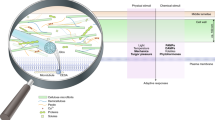Abstract
Cell wall cohesiveness is affected in plants by senescence and pathogen attack. However, the two phenomena are very distinct from each other. Senescence is the result of developmentally regulated processes, whereas pathogen attack is the first of a series of unscheduled events ultimately leading to cell degradation as well as to defense responses. Despite this obvious basic difference, it has been known for a long time that infected tissues share common traits with those undergoing senescence. This includes cell wall hydrolysis, membrane damage, ethylene formation and lipid peroxidation. Cell surfaces play a key role in the two phenomena in that they are involved in, (1) signal generation and recognition, (2) signal transduction, and (3) response to the signal. This paper illustrates the role played by the cell wall and the plasmalemma in plant-microbe interactions.
Access this chapter
Tax calculation will be finalised at checkout
Purchases are for personal use only
Preview
Unable to display preview. Download preview PDF.
Similar content being viewed by others
References
Bell AA (1981) Biochemical mechanisms of disease resistance. Ann Rev Plant Physiol 32:21–81
Bolwell GP, Robbins MP, Dixon RA (1985) Metabolic changes in elicitor-treated bean cells. Enzymic responses associated with rapid changes in cell wall components. Eur J Biochem 148:571–578
Broglie KE, Gaynor JJ, Broglie RM (1986) Ethylene-regulated gene expression: molecular cloning of the genes encoding an endochitinase from Phaseolus vulgaris. Proc Natl Acad Sci 83:6820–6824
Brown IR, o’Connell RJ, Mansfield JW, Bailey JA, Mazau D, Rumeau D, Esquerré-Tugayé MT (1989) Accumulation of hydroxyproline rich glycoproteins in plants at sites of resistance to pathogens. (Submitted)
Chappell J, Hahlbrock K, Boiler T (1984) Rapid induction of ethylene biosynthesis in cultured parsley cells by fungal elicitor and its relationship to the induction of phenylalanine ammonia-lyase. Planta 161:475–480
Collinge DB, Slusarenko AJ (1987) Plant gene expression in response to pathogens. Plant Mol Biol 9:389–410
Davis KR, Hahlbrock K (1987) Induction of defense responses in cultured parsley cells by plant cell wall fragments. Plant Physiol 85:1286–1290
Darvill AG, Albersheim P (1984) Phytoalexins and their elicitors. A defense against microbial infection in plants. Ann Rev Plant Physiol 35:243–275
Ecker J.R., Davis RW (1987) Plant defense genes are regulated by ethylene. Proc Nat Acad Sci 84:5202–5206
Fournier J, Pélissier B, Esquerré-Tugayé MT (1986) Induction d’une activité lipoxygénase dans les cellules de tabac (Nicotiana tabacum) en culture, par des éliciteurs d’éthylène de Phytophthora parasitica var. nicotianae. CR Acad Sc 303:651–654
Gaynor JJ, Broglie R (1985) Defense genes in bean seedlings: induction of chitinase by ethylene. In. Plant Genetics, A Lan R. Liss ed., p 617–627
Kurosaki F, Tsurusawa Y, Nishi A (1987) Breakdown of phosphatidylinositol during the elicitation of phytoalexin production in cultured carrot cells. Plant Physiol 85:601–604
Lieberman M, (1979) Biosynthesis and action of ethylene. Ann Rev Plant Physiol 30:533–591
Mauch F, Hadwiger LA, Boiler T (1984) Ethylene: symptom, not signal for the induction of chitinase and β-l,3-glucanase in Pea pods by pathogens and elicitors. Plant Physiol 76:607–611
Mazau D, Rumeau D, Esquerré-Tugayé MT (1988) Two different families of hydroxyproline-rich glycoproteins in melon callus. Biochemical and immunochemical studies. Plant Physiol 86:540–546
Paradies I, Konze JR, Estner E, Paxton J (1980) Ethylene indicator but not inducer of phytoalexin synthesis in soybean
Pélissier B, Thibaud JB, Grignon C, Esquerré-Tugayé MT (1986) Cell surfaces in plant-microorganism interactions. VII. Elicitor preparations from two fungal pathogens depolarize plant membranes. Plant Science 46:103–109
Roby D, Toppan A, Esquerré-Tugayé MT (1985) Cell surfaces in plant-microorganism interactions. V. Elicitors of fungal and of plant origin trigger the synthesis of ethylene and of cell wall hydroxyproline-rich glycoprotein in plants. Plant Physiol 77:700–704
Roby D, Toppan A, Esquerré-Tugayé MT (1986) Cell surfaces in plant-microorganism interactions. VI. Elicitors of ethylene from Colletotrichum lagenarium trigger chitinase activity in melon plants. Plant Physiol 81:228–233
Roby D, Toppan A, Esquerré-Tugayé MT (1987) Cell surfaces in plant microorganism interactions. VIII. Increased proteinase inhibitor activity in melon plants in response to infection by Colletotrichum lagenarium or to treatment with an elicitor fraction from this fungus. Physiological and Molecular Plant Pathology 30:453–460
Rohwer F, Fritzemeier KH, Scheel D, Hahlbrock K (1987) Biochemical reactions of different tissues of potato (Solanum tuberosum) to zoospores or elicitors from Phytophthora infestans. Accumulation of sesquiterpenoid phytoalexins. Planta 170:556–561
Rumeau D, Mazau D, Panabières F, Delseny M, Esquerré-Tugayé MT (1988) Accumulation of hydroxyproline-rich glycoprotein mRNAs in infected of ethylene treated melon plants. Physiological and Molecular Plant Pathology (in press)
Schmidt WE, Ebel J (1987) Specific binding of a fungal glucan phytoalexin elicitor to membrane fractions from soybean Glycine max. Proc Natl Acad Sci 84:4117–4121
Showalter AM, Bell JN, Cramer CL, Bailey JA, Varner JE, Lamb CJ (1985) Accumulation of hydroxyproline-rich glycoprotein mRNAs in response to fungal elicitor and infection. Proc Natl Acad Sci 82:6551–6555
Toppan A., Esquerré-Tugayé MT (1984) IV. Fungal glycopeptides which elicit the synthesis of ethylene in plants. Plant Physiol 75:1133–1138
Author information
Authors and Affiliations
Editor information
Editors and Affiliations
Rights and permissions
Copyright information
© 1989 Springer-Verlag Berlin Heidelberg
About this chapter
Cite this chapter
Esquerré-Tugayé, M.T., Mazau, D., Rumeau, D. (1989). Signals and Cell Wall Events in Plant-Pathogen Interactions. In: Osborne, D.J., Jackson, M.B. (eds) Cell Separation in Plants. NATO ASI Series, vol 35. Springer, Berlin, Heidelberg. https://doi.org/10.1007/978-3-642-74161-6_15
Download citation
DOI: https://doi.org/10.1007/978-3-642-74161-6_15
Publisher Name: Springer, Berlin, Heidelberg
Print ISBN: 978-3-642-74163-0
Online ISBN: 978-3-642-74161-6
eBook Packages: Springer Book Archive



